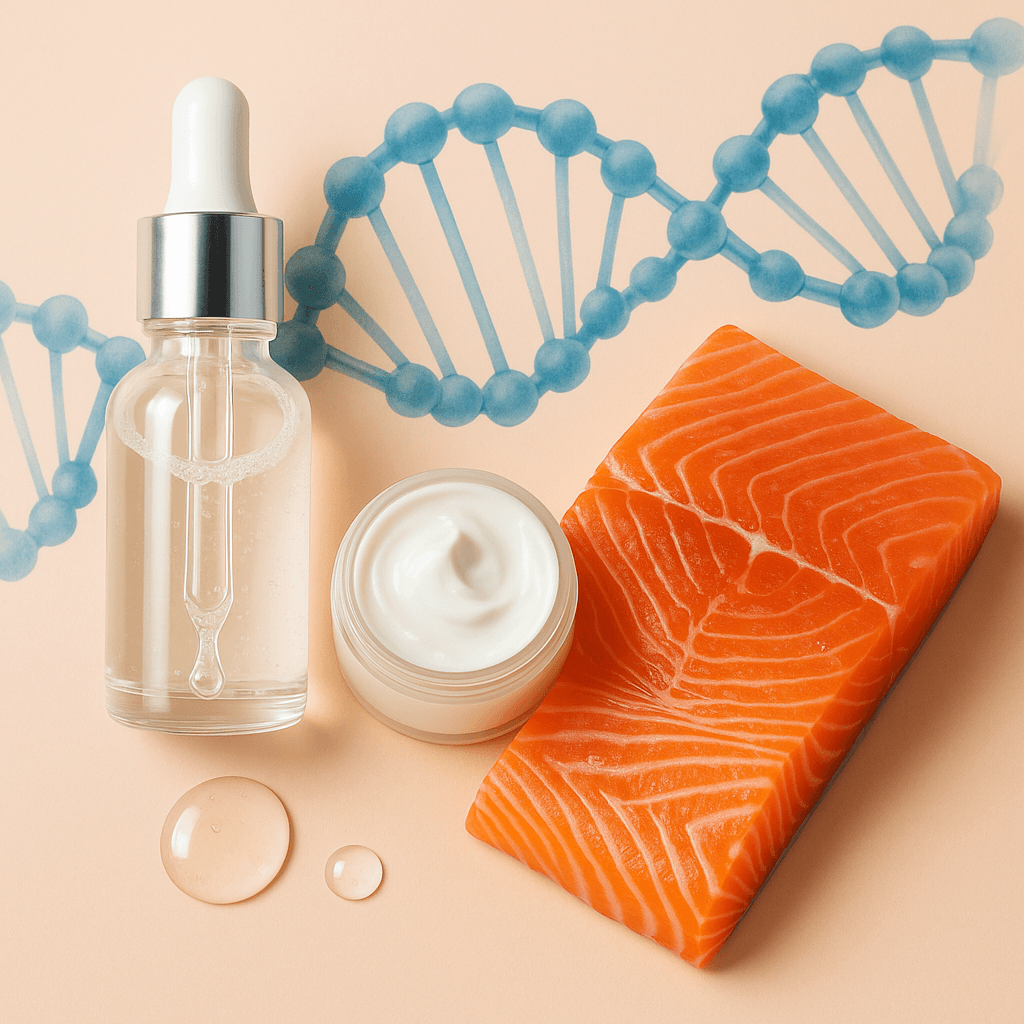
Salmon DNA for Younger Skin: Fact or Just a Trend?

As we age, the skin experiences a decline in elasticity, the appearance of dark spots, and even sagging. Signs of aging are not only experienced by those over the age of 30—many factors can cause this to happen earlier than expected. Skin exposure triggered by oxidative stress from UV rays, consumption of oily foods, smoking, and high sugar intake can accelerate premature aging.
- The Rise of Salmon DNA as an Anti-Aging Ingredient
- Proven Clinical Benefits of Salmon DNA
- How Salmon DNA Works on the Skin
- Laboratory Testing for Salmon DNA Active Ingredient Levels
The Rise of Salmon DNA as an Anti-Aging Ingredient
One of the active ingredients being researched for its potential in preventing premature aging is salmon DNA. This compound is increasingly used in serums and aesthetic treatments due to its claimed strong anti-aging effects. Salmon DNA, also known as polydeoxyribonucleotide (PDRN), used in skincare is typically extracted from salmon sperm.
Its main component is polynucleotides, which are long chains of DNA that are very similar in basic structure to human DNA, making them easily recognized and accepted by the skin. What makes salmon DNA special is its bioactive and biocompatible properties. This DNA is rich in nucleotides and serves as an essential building block in the process of cell regeneration and repair.
The extraction and purification process has a recovery rate of over 95%, which ensures the absence of immunological reactions or contamination from peptides, proteins, or lipids. One of the main factors contributing to skin aging is the accumulation of DNA damage. Therefore, DNA synthesis is crucial for maintaining skin homeostasis.
UV exposure plays a major role in causing DNA damage. A study has shown that UV-induced DNA damage can trigger the release of MMP-1 (matrix metalloproteinase-1), but MMP-1 can be inhibited by the presence of PDRN.
Proven Clinical Benefits of Salmon DNA
The use of PDRN in clinical practice is supported by its proven effects, including anti-inflammatory, anti-apoptotic, anti-osteoporotic, anti-melanogenesis, anti-allodynic, anti-osteonecrotic, bone regenerative, tissue damage preventive, anti-ulcerative, wound healing, and scar prevention effects. With its ability to stimulate angiogenesis (formation of new blood vessels), cell activity, collagen synthesis, reduce inflammation, treat hyperpigmentation, regenerate soft tissue, and rejuvenate and prime the skin, PDRN has shown promise as a potential skin anti-aging agent.
How Salmon DNA Works on the Skin
PDRN works on the skin by repairing its structure from within. Salmon DNA stimulates the synthesis of collagen and elastin, the main proteins responsible for maintaining skin elasticity. Its antioxidant properties also help neutralize free radicals that can damage skin cells. The main component of salmon DNA, polynucleotides, are hygroscopic in nature, meaning they attract and retain water easily.
As a result, the skin becomes more hydrated and maintains its elasticity. Beyond skin benefits, PDRN is also useful for improving hair thickness. A study conducted by Cho S, et al., stated that PDRN injections combined with Platelet-Rich Plasma (PRP) led to an increase in both hair thickness and hair count.
Topical application techniques for PDRN on the skin can be performed in several ways, including direct application or injection into the skin layers. One effective technique to enhance PDRN absorption into the dermis is microneedling, a procedure that uses fine needles to create micro-injuries on the skin. This technique opens channels that allow PDRN to penetrate deeper, thus maximizing its benefits in cell regeneration, collagen stimulation, and skin texture improvement.
Currently, products containing PDRN are available in various forms, ranging from daily skincare products such as creams or serums used topically, to specialized serums that are injected directly into the skin by doctors, procedures that must be performed in certified dermatology or aesthetic clinics. Application by trained medical professionals is essential to ensure the safety and efficacy of the therapy. The effectiveness of PDRN in addressing skin concerns depends on individual skin conditions; therefore, the concentration of the active ingredient and duration of use should be consulted and monitored by a dermatologist to ensure its safety.
Read more:
3 Things to Do Before Launching a Cosmetic Product
Laboratory Testing for Salmon DNA Active Ingredient Levels
To ensure the quality and effectiveness of Salmon DNA's active ingredients, accurate and standardized laboratory testing is required. Through active ingredient assays, the laboratory can determine the actual concentration of polynucleotides (PDRN) contained in the product. These test results serve as a crucial basis for assessing the safety, stability, and ability of the active ingredients to provide anti-aging benefits to the skin, as well as for obtaining a marketing authorization for the product.
References:
Aawrish Khan et al. 2022. Polydeoxyribonucleotide: A promising skin anti-aging agent. Chinese Journal of Plastic and Reconstructive Surgery. Vol 4 (4). Pp :187-193.
Cho S, Zheng Z, Kang J, et al. 2016. Therapeutic efficacy of 1,927-nm fractionated thulium laser energy and polydeoxyribonucleotide on pattern hair loss. Med Lasers. Vol. 5(1):22–28. https://doi.org/10.25289/ml.2016.5.1.22.



